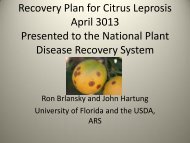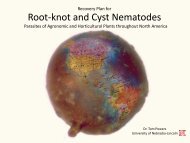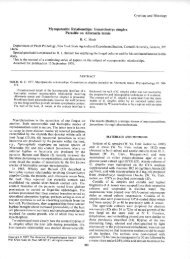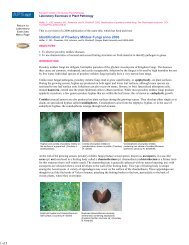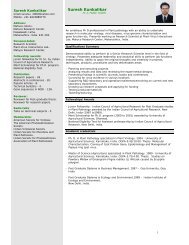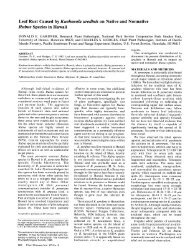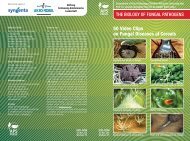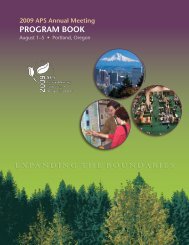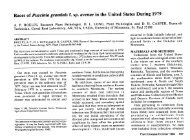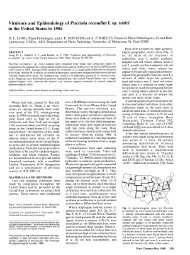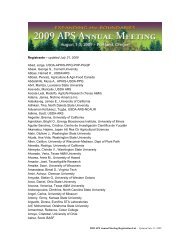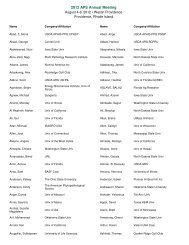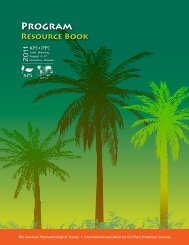view article - American Phytopathological Society
view article - American Phytopathological Society
view article - American Phytopathological Society
You also want an ePaper? Increase the reach of your titles
YUMPU automatically turns print PDFs into web optimized ePapers that Google loves.
of Plant Pathology and Weed Science, Mississippi State Univ.,<br />
Miss. State, MS 39762.<br />
42<br />
Cloned fragments of T-DNA from a wide host range Ti plasmid,<br />
pTi-A6, and from a limited host range plasmid, pTi-Ag63, have<br />
been used as probes in DNA hybridization experiments to determine<br />
the pathogenicity of isolates of Agrobacterium species from<br />
stems, roots and galls of muscadine. Several hybridization<br />
techniques including colony hybridization, slot blot, and Southern<br />
hybridization have been used. These techniques consistently<br />
identify known grape isolates, however, they are less sensitive<br />
when used to probe unknown samples from muscadine isolates.<br />
This suggests that the muscadine isolates may differ from Ag63<br />
in DNA sequence homology. Attempts are being made to use the<br />
polymerase chain reaction as a more sensitive detection technique.<br />
39<br />
EVALUATION OF SEED BIOPSY METHODS FOR NONDESTRUCTIVE SEED HEALTH<br />
TESTING. P. M. Higley, D. C. McGee, J. S. Burris, Seed Science<br />
Center and Dept. Plant Pathology, Iowa State Univ., Ames, IA<br />
A previous report described methoda for extraction and detection<br />
of pathogens from seeds for the purpose of developing nonde-<br />
structive seed health tests. Of particular value was the hiopsy<br />
method of coring tissue from dry seeds. The present work<br />
focuses on optimizing coring techniques to minimize damage to<br />
seed germination. Partial imbibition of corn, soybean, and<br />
Phaseolus seeds facilitated removal of cores, but the combined<br />
effect of imbibing and coring reduced germination compared to<br />
that of seeds that were imbibed only. Treatment of wounded<br />
tissue with a paraffin sealant was an ineffective means of<br />
correcting deleterious effects of coring on germination.<br />
However, reduction of the rate of dry-down by adjusting temperature<br />
and humidity improved germination in cored and imbibed<br />
soybean and Phaseolus seeds. Because corn germination was<br />
unaffected by coring treatments in this experiment, effects of<br />
COMPARISON OF THE ISOLATION OF XANTHOMONAS CAMPESTRIS PV.<br />
CAMPESTRIS FROM CRUCIFER SEEDS IN FOUR SEMISELECTIVE MEDIA.<br />
C. J. Chang', R. Donaldsoni, M. Crowley<br />
these corrective actions were not detected.<br />
2 , and D.<br />
Pinnow<br />
43<br />
2 . lDepartment of Plant Pathology, University of<br />
Georgia and 2 Seed Laboratory, Georgia Department of<br />
Agriculture, Griffin, GA 30223.<br />
INCIDENCE AND SURVIVAL OF SCLEROTINIA MINOR IN PEANUT<br />
D. M. Porter, R. A. Taber, and D. H. Smith. USDA,<br />
SEED.<br />
ARS,<br />
Four semiselective media, CS20ABN, NSCA, NSCAA, and F-S, were<br />
compared for their efficacy in isolating Xanthomonas<br />
campestris pv. campestris (Xcc) from crucifer seeds. Samples<br />
of 50,000 seeds per lot were washed for 2 hr at room temp in<br />
saline. The cheesecloth-filtered washings were centrifuged,<br />
and the resuspended pellets were diluted and pipetted onto the<br />
media. Saprophytic bacteria overgrew Xcc on NSCA and NSCAA<br />
but not on F-S or CS20ABN. Colony-forming units (CFUs) of Xcc<br />
ranged from 66-97 per plate at 10-1 or 37-259 at 10-2<br />
on CS20ABN. Moreover, 59-100% of recovered colonies on<br />
CS20ABN were Xcc, whereas only 4-29% were Xcc on F-S. Colony<br />
size of Xcc on CS20ABN was 2-4 times that on NSCAA or NSCA,<br />
but was 4-7 times that on F-S.<br />
Tidewater Agric. Expt. Sta., Suffolk, VA 23437; Dept. Plant<br />
Path. and Microbiology, Texas A&M Univ., College Sta., TX<br />
77843.<br />
The potential for seed transmission of Sclerotinia minor was<br />
assessed in peanut seed harvested from fields with Sclerotinia<br />
blight. The incidence of S. minor from 'VA B1B' peanut seed<br />
harvested and dried in Virginia according to recommended<br />
procedures was 4.2%. Seed with brown testa were colonized<br />
more frequently (5.7%) than seed with tan or normal colored<br />
testa (2.7%). The incidence of S. minor from seed with brown<br />
testa from five field sites was 3.6, 4.6, 5.0, 7.6, and 7.8%.<br />
The incidence from seed with tan testa from the same field<br />
sites was 1.2, 2.8, 2.8, 3.0, and 3.6%. The incidence of S<br />
minor from seed testa averaged 3.4% while the incidence from<br />
cotyledonary tissues averaged 0.1%. A recommended seed<br />
treatment (Botec 4 oz./cwt) reduced the incidence of S.<br />
to 0.1%.<br />
minor<br />
40<br />
MODIFIED TWEEN MEDIUM FOR DETECTING XANTHOMONAS CAMPESTRIS<br />
PV. VESICATORIA IN TOMATO SEEDS. H. MKlim and N.W. Schaad.<br />
Chonbuk Nat. Univ.,Chonju, Korea and Harris Moran Seed Co., San Juan<br />
Bautista, Ca. 95045.<br />
44<br />
MOISTURE VARIABILITY AMONG INDIVIDUAL SEEDS OF SOYBEAN FROM THE<br />
SAME POD BEFORE HARVESTING. F. A. Lazzari and R. A. Meronuck,<br />
Department of Plant Pathology, University of Minnesota, St.<br />
Paul, MN 55108.<br />
X2712 omsc strspv vesc orl (X v ) i s s e d b orn e in t omat o.<br />
Tween medium A has been described for Isolating Xv from fruit and<br />
leaves (McGuireR.G. etal. Pl. Dis. 70: 887-891). The authors describe<br />
the same medium plus boric acid and Increased cephalexin(Tween B)<br />
for assaying seeds. Dilution platings on test media with xv and<br />
tomato seed washings were done in comparison to KMB. Three of 8<br />
strains failed to grow on Tween B. All strains grew on Tween B only<br />
after reducing cephalexin, tobramycin and boric acid by 46,50 and 67<br />
%, respectively.<br />
incmaio<br />
The<br />
oKBrne<br />
recovery in cfu<br />
rm5-2<br />
of 8 strains<br />
ma<br />
on modified<br />
f7) euto<br />
Tween<br />
in seed flora on Tween B and modified Tween was similar (98 &97%).<br />
Moisture is important in storability of soybeans. Variability<br />
in moisture content (MC) among<br />
may affect<br />
single seeds<br />
susceptibility<br />
in stored<br />
to<br />
soybeans<br />
invasion by storage fungi.<br />
The moisture variability among single seeds of soybean from<br />
different positions inside the same pod was<br />
oven-dried<br />
determined<br />
single<br />
using<br />
The average MC of<br />
seeds<br />
individual<br />
at 103<br />
seeds<br />
C for<br />
from 72<br />
the<br />
hours<br />
respective<br />
in copper<br />
position<br />
cups.<br />
were: 13.20% (seed near pedicel), 12.60% (middle seed), and<br />
11.10% (farthest seed from pedicel).<br />
The fresh weight of single seeds was inversely<br />
to<br />
proportional<br />
seed),<br />
the MC,<br />
and<br />
i.e.,<br />
0.1451<br />
0.1363<br />
g (farthest<br />
g (seed near<br />
seed<br />
pedicel),<br />
from pedicel).<br />
0.1430<br />
While<br />
g (middle<br />
moisture content was highest in seeds nearest the<br />
the<br />
pedicel, the<br />
fresh weight was lowest.<br />
We conclude that variation in MC exists in mature seeds<br />
inside the pod before harvest.<br />
1140 PHYTOPATHOLOGY<br />
45<br />
SUPPRESSION OF STORAGE FUNGI IN GRAIN WITH SOYBEAN OIL.<br />
0. C. McGee, A. lies and M. K. Misra, Seed Science Center,<br />
Iowa State University, Ames, Iowa.<br />
Effects of soybean oil, applied to grain at rates used to<br />
reduce dust in elevators, on storage fungi, were examined.<br />
Corn and soybeans at 17% and 15% moisture content,<br />
respectively, were treated with soybean oil at 200 ppm, alone<br />
or in combination with thiabendazole at 20 ppm, then stored<br />
on-farm in aerated metal bins, with a capacity of 250 kg.<br />
After 12 months, kernel infection by Penicillium and<br />
Asoergillus app was 83.0% and 63.7%, respectively, in<br />
untreated corn, compared to 60.0% and 46.2%, in soybean oiltreated<br />
corn, and 24.7% and 17.0%, in soybean oil +<br />
thiabendazole-treated corn. After 12 months, soybean seed<br />
infection by Penicillium and Aspergillus spp. was 45.7% and<br />
39.2% , respectively in untreated seeds, 17.7% and 8.2% in<br />
soybean oil-treated seeds, and 1.7% and 2.0%, in soybean oil +<br />
thiabendazole-treated seeds. The mechanism for reduction in<br />
storage fungal growth by soybean oil was not fungicidal.



